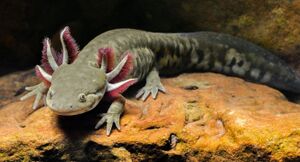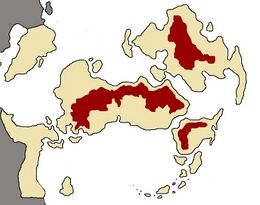Ambystoma puerfluminus: Difference between revisions
old>ContraViper No edit summary |
ContraViper (talk | contribs) No edit summary |
||
| (10 intermediate revisions by 2 users not shown) | |||
| Line 4: | Line 4: | ||
| status_system = IUCN3.1 | | status_system = IUCN3.1 | ||
| extinct = | | extinct = | ||
| image = Inyur_ambystoma. | | image = Inyur_ambystoma.jpg | ||
| image_width = 300px | | image_width = 300px | ||
| image_caption = Ambystoma puerfluminus | | image_caption = Ambystoma puerfluminus | ||
| Line 16: | Line 16: | ||
| binomial = Ambystoma puerfluminus | | binomial = Ambystoma puerfluminus | ||
| binomial_authority = Peron, 1852 | | binomial_authority = Peron, 1852 | ||
| range_map= amby01_range. | | range_map= amby01_range.jpg | ||
| range_map_width = 260px | | range_map_width = 260px | ||
| range_map_caption= Range of ''A. puerfluminus'' in [[Inyursta]] | | range_map_caption= Range of ''A. puerfluminus'' in [[Inyursta]] | ||
}} | }} | ||
'''''Ambystoma puerfluminus''''', also known as the '''Common River Salamander''', '''Inyurstan Newt''', and '''Pésacoja'''; is a species of salamander found in the streams and rivers of [[Inyursta]]. It has the largest home range and highest abundance of any species of Inyurstan salamander. | '''''Ambystoma puerfluminus''''', also known as the '''Common River Salamander''', '''Inyurstan False Newt''', and '''Pésacoja'''; is a species of salamander found in the streams and rivers of [[Inyursta]]. It has the largest home range and highest abundance of any species of Inyurstan salamander. | ||
==Physical Description== | ==Physical Description== | ||
| Line 26: | Line 26: | ||
Maxing out at around 25.4cm (10 inches) long total length, ''A. puerfluminus'' is one of the larger species of non-serpentine salamanders in Inyursta. They come in a variety of patterns, but almost always have some variation of a spotted pattern with a gray or dull-brown skin color. | Maxing out at around 25.4cm (10 inches) long total length, ''A. puerfluminus'' is one of the larger species of non-serpentine salamanders in Inyursta. They come in a variety of patterns, but almost always have some variation of a spotted pattern with a gray or dull-brown skin color. | ||
The Common River Salamander is one of several species of "false newts" found in Inyursta. They are known as such due to their superficial resemblance to juvenile newts, as well as their aquatic lifestyle. | The Common River Salamander is one of several species of "false newts" found in Inyursta. They are known as such due to their superficial resemblance to juvenile newts, as well as their aquatic lifestyle. Most species of {{wp|Mole salamander|Ambystoma}} found in Inyursta are either fully paedomorphic, or predominantly paedomorphic with facultative terrestrial adult morphs. As such, they retain the paddle-tail and gills their entire lives. Terrestial adult morphs of A. puerfluminus have only been raised in captivity. | ||
==Habitat== | ==Habitat== | ||
| Line 32: | Line 32: | ||
Common River Salamanders are found in both slow and fast-moving waters at a variety of altitudes, although they are absent from many areas of the coastal plain. They are associated with clear-water systems with neutral pH's and a wide range of dissolved oxygen levels. Suitable bodies of water are usually ranked as 1 - 3 on the {{wp|Strahler number|Strahler River Classification}}, but sometimes level 4 rivers and even the side-branches and off-shoots of level 5 rivers may contain thriving populations. | Common River Salamanders are found in both slow and fast-moving waters at a variety of altitudes, although they are absent from many areas of the coastal plain. They are associated with clear-water systems with neutral pH's and a wide range of dissolved oxygen levels. Suitable bodies of water are usually ranked as 1 - 3 on the {{wp|Strahler number|Strahler River Classification}}, but sometimes level 4 rivers and even the side-branches and off-shoots of level 5 rivers may contain thriving populations. | ||
Preferred substrates include rock bottoms, gravel and coarse sand sediment. The subspecies A. puerfluminus melanosa frequents pools with high amounts of green vegetation and submerged wood features. | Preferred substrates include rock bottoms, gravel and coarse sand sediment. The subspecies ''A. puerfluminus melanosa'' frequents pools with high amounts of green vegetation and submerged wood features. | ||
==Trophic Niche== | ==Trophic Niche== | ||
Common River Salamanders are | Common River Salamanders are mid-level mesopredators in the stream and creek ecosystems. Typical prey items include aquatic insects, small fish, smaller amphibian larvae and sometimes crustaceans such as aquatic crayfish and freshwater crabs (''A. p. melanosa''). Less common prey items include worms, other salamanders and even surface insects. | ||
The primary predators of this species are water snakes of the {{wp|Helicops}}, {{wp|Nerodia}} and {{wp|Liophis}} genera. Secondary predators include mammals such as otters and mustelids, while in larger bodies of running water they are vulnerable to predation by large fish and sometimes juvenile and subadult crocodilians. | The primary predators of this species are water snakes of the {{wp|Helicops}}, {{wp|Nerodia}} and {{wp|Liophis}} genera. Secondary predators include mammals such as otters and mustelids, while in larger bodies of running water they are vulnerable to predation by large fish and sometimes juvenile and subadult crocodilians. | ||
== | ==Distribution== | ||
The Common River salamander is found on all three major "islands" of the Inyurstan subcontinent. Recent genetic evidence has revealed partitioning dating back to less than 10,000 years (+/- 3.7 thousand), implying that either the species was able to hitch-hike other native species, or were introduced by indigenous people's to various aquatic systems across what is now Inyursta. | |||
' | |||
The [[Ambystoma natator|Rio Neige Black Axolotl]] was historically considered a subspecies of A. puerfluminus; but this same genetic evidence elevated A. natator to full species status. | |||
==See Also== | |||
===Related Species=== | |||
[[Ambystoma bardus|Striped axolotl (Ambystoma bardus)]]<br /> | |||
[[Ambystoma natator|Rio Niege Black axolotl (Ambystoma natator)]]<br /> | |||
[[Ambystoma arenos|Lapenter's axolotl (Ambystoma arenos)]]<br /> | |||
[[Ambystoma atricolor|Marindinoan Black mole salamander (Ambystoma articolor)]]<br /> | |||
[[Ambystoma sanjuaniensis|Sierran Black mole salamader (Ambystoma sanjuaniensis)]]<br /> | |||
===Inyurstan Species Lists=== | |||
[[Inyurstan Herpetofaunal Checklist]]<br /> | |||
[[Species Endemic to Inyursta]] | |||
===Relevant Scientists=== | |||
[[Simon Péron]] - Described the species<br /> | |||
[[Marina Sant-Yves|Dr. Marina Sant-Yves]] - Lead researcher of post-2010 genetics analysis | |||
[[Category:Inyursta]] [[Category:Inyurstan Wildlife]] | [[Category:Inyursta]] [[Category:Inyurstan Wildlife]] | ||
Latest revision as of 03:02, 26 December 2023
| Common River Salamander | |
|---|---|

| |
| Ambystoma puerfluminus | |
| Scientific classification | |
| Kingdom: | Animalia
|
| Phylum: | Chordata
|
| Class: | Amphibia
|
| Order: | Caudata
|
| Family: | Ambystomatidae
|
| Genus: | Ambystoma
|
| Species: | A. puerfluminus
|
| Binomial name | |
| Ambystoma puerfluminus Peron, 1852
| |

| |
| Range of A. puerfluminus in Inyursta | |
Ambystoma puerfluminus, also known as the Common River Salamander, Inyurstan False Newt, and Pésacoja; is a species of salamander found in the streams and rivers of Inyursta. It has the largest home range and highest abundance of any species of Inyurstan salamander.
Physical Description
Maxing out at around 25.4cm (10 inches) long total length, A. puerfluminus is one of the larger species of non-serpentine salamanders in Inyursta. They come in a variety of patterns, but almost always have some variation of a spotted pattern with a gray or dull-brown skin color.
The Common River Salamander is one of several species of "false newts" found in Inyursta. They are known as such due to their superficial resemblance to juvenile newts, as well as their aquatic lifestyle. Most species of Ambystoma found in Inyursta are either fully paedomorphic, or predominantly paedomorphic with facultative terrestrial adult morphs. As such, they retain the paddle-tail and gills their entire lives. Terrestial adult morphs of A. puerfluminus have only been raised in captivity.
Habitat
Common River Salamanders are found in both slow and fast-moving waters at a variety of altitudes, although they are absent from many areas of the coastal plain. They are associated with clear-water systems with neutral pH's and a wide range of dissolved oxygen levels. Suitable bodies of water are usually ranked as 1 - 3 on the Strahler River Classification, but sometimes level 4 rivers and even the side-branches and off-shoots of level 5 rivers may contain thriving populations.
Preferred substrates include rock bottoms, gravel and coarse sand sediment. The subspecies A. puerfluminus melanosa frequents pools with high amounts of green vegetation and submerged wood features.
Trophic Niche
Common River Salamanders are mid-level mesopredators in the stream and creek ecosystems. Typical prey items include aquatic insects, small fish, smaller amphibian larvae and sometimes crustaceans such as aquatic crayfish and freshwater crabs (A. p. melanosa). Less common prey items include worms, other salamanders and even surface insects.
The primary predators of this species are water snakes of the Helicops, Nerodia and Liophis genera. Secondary predators include mammals such as otters and mustelids, while in larger bodies of running water they are vulnerable to predation by large fish and sometimes juvenile and subadult crocodilians.
Distribution
The Common River salamander is found on all three major "islands" of the Inyurstan subcontinent. Recent genetic evidence has revealed partitioning dating back to less than 10,000 years (+/- 3.7 thousand), implying that either the species was able to hitch-hike other native species, or were introduced by indigenous people's to various aquatic systems across what is now Inyursta.
The Rio Neige Black Axolotl was historically considered a subspecies of A. puerfluminus; but this same genetic evidence elevated A. natator to full species status.
See Also
Related Species
Striped axolotl (Ambystoma bardus)
Rio Niege Black axolotl (Ambystoma natator)
Lapenter's axolotl (Ambystoma arenos)
Marindinoan Black mole salamander (Ambystoma articolor)
Sierran Black mole salamader (Ambystoma sanjuaniensis)
Inyurstan Species Lists
Inyurstan Herpetofaunal Checklist
Species Endemic to Inyursta
Relevant Scientists
Simon Péron - Described the species
Dr. Marina Sant-Yves - Lead researcher of post-2010 genetics analysis